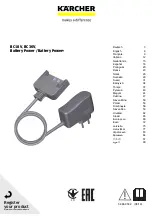
4
For best results, charge the battery tool in a location
where the temperature is more than 10°C but less
than 37°C. To reduce the risk of serious personal
injury, do not store outside or in vehicles.
BATTERy chARGING INFORMATION
Charging rates for NiCad and/or Li-Ion battery
charging rates are determined by the time taken to
fully charge the battery and are determined by the
charge current. The three most commonly used
charging rates are typically:
Fast charge.
Slow charge.
Trickle charge.
FAST chARGE BATTERIES
The charging rates for fast charge batteries can vary
between 30 minutes and 90 minutes. The charging
rate for the battery supplied with a cordless power
tool is stated in the product manual.
SLOw chARGE BATTERy
The charging rates for slow charge batteries are
between 3 hours and 5 hours.
TRIcKLE chARGE BATTERIES
The charging rates for trickle charge batteries are
between 7 hours and 9 hours.
IMPORTANT!
NIcAD AND/OR LI-ION BATTERy chARGING
INFORMATION.
ALwAyS FULLy DISchARGE A Nicad and/or Li-
Ion BATTERy BEFORE chARGING AND NEVER
EXcEED ThE chARGING RATE TIME, EXcEPT
whEN “cONDITIONING” A NEw BATTERy.
chARGING PROcEDURE
When charging a new NiCad and/or Li-Ion battery it
should be fully discharged followed by a full charge
for the charging rate for the battery as stated in the
product manual plus 30 minutes. This should then be
followed by a full discharge and a further full charge
for the charging rate for the battery as stated in the
product manual plus 30 minutes. This procedure will
condition the battery and equalise the cell voltages.
Following this procedure will ensure the optimum
operation of the battery.
When repeatedly using the charger to charge a
number of batteries always allow the charger to cool
down before charging another battery. It is
recommended that the cooling down period is not
less than 30 to 45 minutes.
When charging a battery that has been discharged
during heavy use allow the battery to cool down
before charging. It is recommended that the cooling
down period is not less than 30 to 45 minutes.
NOTE: If the charger does not charge the battery pack
under normal circumstances, return both the battery
pack and charger to the nearest FXA authorised
service centre for electrical check.
NIcAD AND/OR LI-ION chARGING & chARGERS
NiCad and/or Li-Ion batteries need to be recharged
with a reasonable amount of care, largely because
they can be damaged by overcharging.
Overcharging can result in the battery temperature
and internal pressure to rise rapidly. This can cause
the cells to distort and lose electrolyte, and in extreme
cases where the internal pressure is extremely high
they can even explode.
This situation can also arise when an overcharged
battery is fitted to the product and is being used. In
order to avoid this extreme situation it is of vital
importance that NiCad and/or Li-Ion batteries are fully
discharged before charging and that the charge time
is not exceeded except when “Conditioning” a new
battery. Repeated charging of partially discharged
batteries could cause failure of one or more of the
cells.
SELF DISchARGE
A lithium battery can self discharge and lose its stored
charge. Typically it can lose approximately 5% of its
charge in the first month after fully charging (when
stored at room temperature), and then loses it by a
further 3% per month. When stored at higher
temperatures the self discharge rate will be
accelerated.
BATTERy chARGING INDOORS
This charger is designed to be used indoors. We do
not recommend that it is used inside your home.
Ideally batteries should be charged on a bench in a
workshop, garage or shed. If the charging operation is
to be carried out in your home the area must be well
ventilated and the charger must be placed on a non
combustible surface ensuring that the ventilation slots
are not blocked. Never exceed the charging time
except when “Conditioning” a new battery, as this
could damage the battery and charger.
BATTERy DISPOSAL
When the battery fails to charge or maintain its
charge, its usable life is exhausted. To preserve
natural resources, please recycle or dispose of the
battery pack properly. This battery pack contains li-ion
cells. Before disposal ensure that the battery pack is
fully discharged by operating your cordless product
then remove the battery pack from the drill housing
and cover the battery pack connections with heavy
duty tape, to prevent short circuit and energy
discharge which could result in a fire. Do not attempt
to open or remove any of the components.
Consult your local waste authority for information
regarding available recycling and / or disposal
options.
SPEcIFIc SAFETy INSTRUcTIONS
RE-chARGEABLE BATTERIES.
Batteries may leak or explode if not charged or
handled correctly. Always observe the following
precautions when handling batteries.
Summary of Contents for FXA FXAJDB180Li
Page 2: ...2 1 1 3 2...
Page 23: ...23 2 10...
Page 24: ...24 25 35 10 C 37 C 30 90 3 5 7 9 30 30 30 45 30 45 FXA...
Page 25: ...25 5 3 1 18 230 50 FXAJDB180Li FXADL1051 FXAJDB180Li II 1 2 3...
Page 27: ...27 Li ion WEEE...
Page 47: ...47...





































